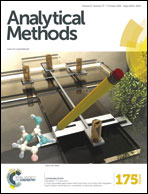Specificity of high resolution analysis of naphthenic acids in aqueous environmental matrices†
Abstract
The determination of naphthenic acids to ultra-trace level is reported using liquid chromatography with quadrupole time-of-flight mass spectrometry detection (LC/QToF). The application of this method is in the rapid screening for low level oxygenated naphthenic acid species from potential oil sands process water (OSPW) spills and leakage from storage facilities into aquafers and waterways. During LC/QToF method optimization it was found to be essential to adjust sample pH to >10 prior to any sample container transfer or sub-sampling in order to avoid naphthenic acid losses. Under acidic conditions the loss of O4 species from AEOs was shown to range from 17% for earlier eluting C17 species, to 86% for a later C21 species. Despite application of high resolution mass spectrometry with a mass accuracy of 5 ppm, the potential for interference from environmental contaminants was demonstrated for recognized estrogenic contaminants, resin acids, and fatty acids. These contaminants occur in the environment from natural and human activity, for example fatty acids derived from the pulp and paper mill industry upstream of the Athabasca oil sands. In an effort to avoid potential false positive identifications at low NA concentration levels, formulae for Cn z-0 O2 fatty acids were excluded from total NA screening. It was further noted that OSPW-derived acid extractable organics (AEOs) and Merichem technical mixtures contained ∼2.5% and ∼1.8% respectively of compounds identified with formulae equivalent to both naphthenic and resin acids. The C20 resin acids, anticipated at higher levels in dystrophic water samples, were recommended for future exclusion. Similarly, estrogens, namely estrone, 17α-ethinylestradiol, and 17β-estradiol estrogens, were also identified as NA during screening but eluted at different retention times to the naphthenic acid homologs observed in NA technical mixtures. The potential for their erroneous inclusion in total naphthenic acid results is also discussed.


 Please wait while we load your content...
Please wait while we load your content...